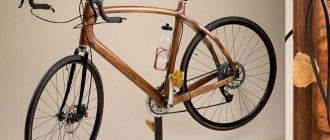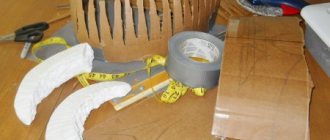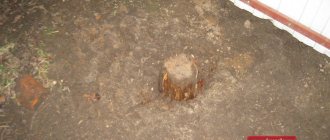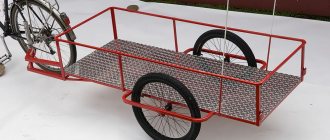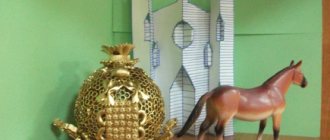A shield is the defensive equipment of warriors, which served as good protection against bladed and thrown weapons. Previously, when there were no firearms, almost every warrior had to have a shield, because they understood that their life depended on it. Shields have been created since ancient times, and until our time they have undergone many changes.
How to make a shield with your own hands?
We will show you how you can make a beautiful medieval shield from simple materials that you can find in your local stores, or even at home.
For our future shield we will need:
• Plywood • Bolts • Canvas awning • Paints • Glue • Nails • Suede • Leather belt
Having prepared everything, we can begin development. Here is a rough outline of what we will do:
Let's get started!
1. First of all, we get to work with plywood. Having decided on the dimensions, we transfer them to the shield and cut them out. Here are the dimensions of our shield:
Scheme of how to correctly mark the shield:
2. Plywood can be made slightly rounded, but only if there are special tools. If this is not possible, then you can leave it simple and flat.
3. When the workpiece is ready, we seal the front part with a canvas awning. To do this, cut out the canvas a little larger than the shield and glue it with glue. The edges should be folded into the middle.
4. Next, you need to install the belts. Here is the diagram according to which we will do the installation and marking:
5. We make holes for the belts and glue the suede part (we use glue and small nails), it is needed so as not to constantly scratch your hand on the plywood.
6. We fasten the belts with bolts.
7. The last step is painting the shield. Each nation colored its shield in a special way, because it was an indicator of belonging to the warrior state.
This is how we arrived at the final result – the finished shield!
VIDEO. How to make a shield out of wood?
Hello. Today we will talk about how you can make a shield with your own hands for role-playing games, or simply for the purpose of reconstructing ancient weapons and armor. Previously, we already looked at material about making a sword and scabbard, and also weaved chain mail. Now it’s the turn for the front line of defense of the medieval warrior - the shield. The shield should not only be durable and impact-resistant, but also lightweight. Therefore, think about what kind of wood, and we will make the shield from it, you will use. The best option for making a shield would be birch. This type of wood has not only good viscosity and elasticity, but also lightness compared to other alternative woods. Next, you need to decide on the size of the shield. A shield with a diameter of 600-700 mm is considered optimal. Such a shield will completely protect the forearm (from elbow to hand) and at the same time will not be too heavy.
Medieval shield manufacturing technology
The boards for the board must be well dried, have a straight-layer structure and do not have large knots. So, the shield manufacturing technology is as follows. Take a birch board measuring 2100x200x40, already pre-planed, and saw it into four parts. You should have two pieces of 620 mm each and two pieces of what remains. Carefully plan and fit the side edges of these boards tightly to each other. From these pieces we will glue the base of the shield. Use plasticized PVA glue. Leave to dry overnight.
Now we need to plan the planes of the shield blank in order to smooth out the joints of the boards, removing the steps. Next, we outline a circle with a radius of 300 mm and cut it out with a jigsaw.
Next we need to make our shield blank convex. To do this, on one side we plan with a plane, going deeper from the edge to the middle, and on the other hand, on the contrary, from the middle to the edge. As a result, we should get a kind of wooden lens 15-17 mm thick.
Well, we have the wooden base of a homemade medieval shield ready. Now let's get to the metal.
In the center of the shield there should be a convex bowl called the umbo. The umbo can be knocked out from a round metal plate 1.5 - 2.5 mm thick, placing it on a lead pad, and tapping with a hammer from the center in a diverging spiral until a convex dome is obtained with a diameter of 150-200 mm and a depth of 50 mm. We bend the edges on an anvil to a width of 15-20 mm. This is how cold forging is performed. But, in order to upset the cup to such a depth, you need to use hot forging, heating the metal with a gas burner or in a forge until red, pressing the metal in a ring mandrel or matrix. However, if blacksmithing is new to someone, he can order an umbon from a forge, or buy something similar in a store.
Now we need to forge the edge of our medieval shield with iron. To do this, we again need an anvil and a hammer to bend a steel strip two millimeters thick along a radius of three hundred millimeters in a plane. We place the strip on the anvil and begin to flatten one edge with a heavy hammer, periodically checking its curvature with a cardboard template. If your strip is made of ductile metal, then cold forging will be enough for you. But still, it is better to anneal by heating the strip with a gas burner until red and letting it cool slowly. After that, we continue to hit it with a hammer. It is not necessary to bend the strip along the entire circumference of the shield. You can divide it into several separate parts. It will be a little easier this way. Although the work is quite hard. We adjust the metal to the shield so that there is an edge left for bending to the thickness of the shield. Bend the edge ninety degrees can be done on an anvil. To do this, we replace one of the “lips” of the vice with a plate, the upper edge of which is curved along a radius of 300 mm, that is, along the circumference of our shield.
We carefully adjust the finished edging of the shield ribs to each other and attach them to the shield using bolts, which we will later replace with rivets. We also screw the umbon to the middle. Now we need to work on the remaining parts of the shield. We need to cut twelve shield covers from sheet iron using a jigsaw. The photo clearly shows what shape they should be. But you can show your imagination and make something of your own. The plates can be riveted to the panel with furniture bolts. We rivet from the inside of the shield, placing wide washers on the bolt rod. We saw off the rod so that it extends two or three millimeters above the surface of the shield.
Read also: DIY reversible plow for a walk-behind tractor, drawings
Now we just have to make the shield holding elements. To do this, we need to carve a wooden handle (you can use a copper or brass tube) and rivet it from the inside of the shield. The forearm belt loop is made of leather, 70mm wide in the center and 40mm wide at the edges. We attach it to the shield also using through rivets. But the forearm pillow can be screwed to the shield with bolts with a rounded head.
Well, that's probably all. Our medieval shield is completely ready. You can start role playing, or hang it on the wall as decoration next to your other remodeled items. Good luck!
The article is a rewrite. Photos taken from the book “Reconstruction of Ancient Weapons”
| Plywood board base |
I made some shields using my shield press. And this article will describe in detail how to make a knight's shield. You can make yourself a shield in almost any shape you want (historical or not), and for the most part the construction methods will be the same. And to the question of historicity: in the Middle Ages, the bases for shields were made from boards, but modern plywood shields are faster and easier to manufacture and are not inferior in strength to planks. And the “non-historicity” of a plywood board is easily hidden under canvas or leather painted with authentic paints.
I hope my drawings and examples give you enough information to try making your own shield.
| Close-up photo of my shield. I painted this shield to match my surcoat. Since this shield is mainly for gaming, I used bolts - since they are much lighter than rivets. |
| This is a pretty standard almond shaped shield. I painted it like a Templar shield. I tried to make this one a little more historical and the straps are attached using rivets. Also, I didn't use any buckles to adjust the straps. I will show this in detail later. |
| These photos just show some close-ups. |
| A few more shots from different sides of the shield. Here, buckles were used to adjust the straps. This shield has just been primed and is ready to be painted. I always paint first before attaching the armrest pad and straps. This is much easier than trying to paint around them. |
Almond Shield Drawings
up
Below are some dimensions for a standard Kite Shield, also known as the almond and Norman shield, described in more detail here - Knight's shields of the 11th to mid-12th centuries. Sizes suggested are suggestions only, feel free to customize them to suit your needs.
Fig.1. Manufacturing stages:
- 1) Norman round shield
- 2) Umbon
- 3) Finished shield: a - internal part;
- b - outer part.
The round shield was used by horsemen and infantrymen. Medieval craftsmen made it from wooden planks and then stretched leather over it. On top, the shields were decorated with various decorative elements made of bronze and copper. The hand was protected by the umbon. An umbo is a hemisphere or cone held with a handle or strap. To make a Norman shield with a diameter of 0.8-0.9 m, we will need planed container boards. They are glued to each other end to end using epoxy glue. To add strength to the resulting structure, 2 transverse slats are glued to the top of it. Their width is 5 cm, thickness - 0.5 cm. Then the shield should be given a rounded shape, for which the wooden blocks are sawed off. In the center you need to drill a hole for the umbon. Next you should think about how to make the shield stronger. To do this, the transverse slats are nailed. If there are any protruding ends of the nails left, bend them down using pliers.
How to make a shield: making a umbon
In order to make an umbon, you will need a tin can. Its sharp edge can be easily beaten with a hammer. The resulting blank is inserted into the hole in the shield and glued with epoxy glue. You can make the umbon yourself, but if you want it to be convex, it is better to do it using a lathe. We glue a carved umbon to the bottom of a tin can inserted into the shield. We still use the same epoxy glue. The shield is turned over with its reverse side and a wooden handle is nailed in the place where the umbo is located, after which it is braided with leather. Take a rubber hose and cut it lengthwise. It will be the rim of the shield. It is attached to the product using wallpaper nails. If there are none, then wire is used instead, but this will first require drilling holes for it. The fastening ring of the umbon is made of polystyrene and glued with Moment glue. The thickness of the polymer is taken to be approximately 1 mm.
How to make a shield with a decorative coating
Now let's think about how to make the shield look like a real one. For the decorative coating of the shield, waterproof varnish and wood stain are used. All wooden parts are treated with stain. Then the product is varnished. To make the rivet heads and umbo look like metal, they are painted with paint that imitates the color of metal. There are different options for painting the shield: single-color, checkerboard or alternating colors.
How to make a shield with a cut edge
Fig.2. Shield with a cut top edge:
- 1) Blank;
- 2) Finished shield: a - internal part;
- b - outer part.
In a later period of time, knights acquired protective armor, the upper edge of which was cut flat. To make a convex shield, it is better to take plywood. Its thickness should be 3-5 mm. We cut out a circle of the required diameter from it, soak it in very hot water until it becomes very flexible. Having given the plywood the desired shape, you should fix it in this position with a rope. When the shield is completely dry, it must be removed. To paste the shield, canvas or drawing paper is used. They are glued to the surface of the armor. The rim is made from a lengthwise cut rubber hose, which is attached to the product using wire or wallpaper nails. The straps are attached inside and outside with rivets. Cut a piece of felt from the felt boot and glue it to the shield under the handle.
If you are a roleplayer, then you probably need good equipment, such as a shield, which you can make yourself. In this article we will talk about how to make a shield with your own hands.
Plywood board base
up
The first thing you want to do to make a shield is determine its dimensions. They may vary slightly, but let's assume that we are going to make our heraldic shield 53.3 cm (21 inches) wide at the top. This triangular shape is much easier to draw the shield shape before bending it in the press.
I prefer my shields to be curved, but this is generally not necessary. I use 2 pieces of 0.63 cm (1/4″) plywood, and when they are glued together in a press, the board is 1.25-1.3 cm (1/2″) thick. If you just want to make a flat panel, you can simply use a piece of 1.3 cm (1/2″) plywood.
The standard backboard is designed using the 3 to 1 method. Notice in the photo above that the backboard is 3 points wide, the straight section on each side is 1 point and the curve is created using 3 points. So if the shield is 53.3 cm (21″) wide, then you divide these measurements by 3 and you get 17.8 cm (7″), that is one point.
The picture above shows the old trick of marking a large curved line. I use a piece of 0.63 cm (1/4″) thick plywood with a 3.8 cm (1 1/2″) wide board, but almost any board you have on hand will work. I make a slot at one end of the board (where the nail will go), and I drill at some predetermined distance at the opposite end a hole large enough for a pencil, which I will use to mark the edges of the future board.
The distance between the starting point of the marking and the pencil hole is 3 points, in this case 53.3 cm (21 inches).
You will drive the nail at the end of the left side of the straight line (which in our example would be 17.8 cm (7″) away. Don't drive the nail too deep, just enough to hold just a little. Then you place a pencil at the end of the line on the right side and draw a curve.Repeat for the other side and your shield is ready to be glued, pressed and cut.
There are many examples of different types of panel presses, but I have a method described here: Press for gluing plywood panels.
After the shield blank has dried in the press (several days), you can take it out and cut it out using a jigsaw or band saw.
Once you have cut out the future shield, you sand the edges with sandpaper to make them smooth and correct any splinters or imperfections. You can also sand the front and inside of the shield a little if you like, just to smooth it out a bit. I also round the edges with a rasp, a little, so that the edges are not sharp.
What is it for?
The shield is needed by parents who have small children, because a child may need a knight costume for the New Year, and he will need a sword and shield. But the shield can also be useful for an adult. Various costume parties, theatrical performances and accurate reenactments of knightly battles may require participants to carry a shield.
First of all, when planning to make a shield from any material, you need to decide on its size and shape. You can make a rough drawing on paper to make sure the dimensions are correct.
Also, lovers of knightly armor should know that shields come in different shapes: long almond-shaped, shorter oval. You also need to think in advance about the coloring of the shield and, depending on this, select the material for its manufacture.
Covering the edges and front panel of the shield
up
I like when the outside of the shields are covered with some kind of material, as it gives them a more historical look, adds strength and makes them easier to paint. I prefer to use canvas (burlap tarpaulin) as it is inexpensive, easy to work with and you can get it at any fabric store. You can also use linen fabric, but it is not as durable, harder to find, and more expensive than canvas. You can also use leather, and it is best to use it on the shield where you are going to cover the edges with rawhide strips. The following instructions assume that we are using a canvas.
I start cutting a piece of canvas with the expectation that it will be 5 cm larger than the size of the blank for the shield. Then I use wood glue to glue it to the front panel. I take a cheap brush and shorten the bristles until there is only 1.6cm (1/2″) of bristles left or so. This makes a good brush for applying wood glue. Next, apply glue to the front panel of the shield, covering about half of the panel for now. You don't need a lot of glue, a good even layer holds up very well. Once you have applied the glue to half of the shield and laid down the canvas and your side you need to smooth it down so that it comes into contact with the glue. If you have glue coming out of the material and getting your hands dirty, then you most likely applied too much glue, but it really won't hurt. Repeat these steps for the rest of the shield until the entire front panel is covered. Don't worry about covering the edges of the shield yet, just wait until the glue hardens first.
Read also: Sharpening machine for metal turning tools
After the glue has dried on the front panel (about 1 hour), you are ready to wrap the shield blank around the edges. If you are using rawhide upholstery around the edges, you don't need to wrap canvas around the edges.
The first thing you need to do is mark the fabric where and how it will need to be cut. Let's say you want the canvas to extend 2.54 cm (1″) onto the back of the shield (see right picture above). To make it even and maintain the shape, you can use a compass (picture above left) to mark everything around the canvas, along the edge of the shield. Since the shield is 1.27 cm (1/2″) thick, you want all of this material to be about 3.8 cm (1 1/2″) wide.
If our shields were square, then upholstering the edges would be easy, you only need to wrap the canvas once and glue it to the edges and back, but since our shields have curved sides, we need to overlap the material from time to time and keep it that way position
These pictures show the floors. The number and magnitude of overlap will be determined by how much the shield is curved in the area in which you are working. Just experiment with folding on the canvas and trimming the overlaps so they can form a neat curve along the edge of the shield. Remember that we are more interested in the front panel and top edge looking good.
When you glue the canvas, make sure you apply glue to the edge and of course to the back. If the glue runs out from under the canvas, don't worry. The paint will cover it as you paint the back of the shield. Smooth out the canvas with your fingers (this job can get a little tricky :>). Wood glue is a little slippery and will pull the canvas down even when wet, but as the glue dries you can go back and work on areas that may not have been glued.
When you cut the canvas for the overlap - do not cut all the paths to the back panel of the board, only those that bend to the rear edge, the marking of the area is shown by the line in the pictures above.
The host will form tufts in the corners and curves of the shield. I don't have any magic, but only once was I able to cut the canvas to fit as well as possible. Use enough glue here to stick the canvas. Then smooth the canvas and wipe away any excess glue. I then use clamps on each of the corners to hold the canvas while the glue dries. I then check the canvas that I glued to the back one more time, smoothing out any tufts that might have been marred a little. You can also add a little more glue and use it to smooth the tufts down a bit.
The above guidelines may seem a little complicated, but don't worry too much. It's not all that bad, and once you get started, it flows pretty well.
Now you can put the shield aside and let it dry.
Using leather to cover the shield.
If you will be covering the front of the shield with leather, you simply cut the leather to fit the front of the shield and glue it in place using wood glue. Remember that you will need to use rawhide to wrap the edges. More on this below.
If you feel strong, you can try to bend the skin around the shield, just like it would be a canvas. It's not easy, but it can be done. You would have to have the leather soaked in water, this will make it easier to form the covering of the shield.
Painting the shield, installing belts
up
Paint, I only use standard latex wall paint. I put 2 layers on the front and back of the shield. I took a small painting set and it’s enough for me to paint the shield. You may want to paint the front and back panels of the shield before installing the straps and padded armrest. The color is your choice! Again, I just used standard latex wall paint. I used something called egg tempera for a shiny finish, but again, it's up to you. Historically the paint job was probably flat. Egg tempera will be a little tougher. I use this on the front and back of the shield. If you will be covering the front panel of the shield with leather, you will need to use a paint that is compatible with leather, acrylic paints are most suitable.
If you are adding the Umbo to your shield, you will need to do it now before adding the armrest and straps. You can draw a place for the umbon on the front panel of the shield, depending on the design. Again, it’s easier to draw when the Umbon is there but not yet installed, then you can drill the holes and install it for now only for testing.
Soft armrest
up
When installing an armrest, you are limited only by the size of the space for the platform and belts, the size of the back panel of the shield, your own dimensions, and simply personal preferences. To give you instructions, I've drawn a drawing above that shows the measurements I used on my personal shields. The angle of the armrest is about 30 degrees, but you can have someone hold the shield while you move your arm around to get the angle that suits you best. Please note that all dimensions are approximate and may be subject to change at your discretion.
Next we want to make our armrest. I use chamois for the top cover as it is durable but flexible. You can use other materials, just make sure they are strong enough. You could use canvas, just make sure you fold the edge down slightly a few times to keep it from unraveling. I use a 1.9cm (3/4″) thick piece of padding from a fabric store. Just make sure you get padding polyester, not polystyrene foam. Your hand will thank you later.
Read also: How to make a throwing knife from wood
I use small nails to attach the chamois to the back of the shield. Before attaching, you need to try and figure out where your hand will be on the backboard. You can use my photos as examples. Once I figured out where I want it, I nail the suede from top to bottom, and to the sides. I use 1 cm (3/8″) cloves. You don't want the studs sticking out of the front panel - so they are shorter than the thickness of the shield. After I attach the suede to the top and sides, I place the filling underneath the suede. The filler is trimmed so that it is slightly smaller than a piece of suede. And then we nail the remaining sides of the suede.
Belts
up
The picture above shows several different examples of belts that can be used. The first standard belt that uses a buckle for adjustment. The second belt consists of two crossed belts. Crossed straps work best for the strap you hold in your hand. If you notice, my red and black shield (at the top of this page) are made using this method. Works very well.
The final strap, the lace strap, uses a series of holes for leather laces to allow for modifications. It's used on my Templar teardrop shield (also at the top of the page). It's not as easy to adjust as, say, a belt with a buckle, but the method is historical.
For reference, the straps on the heraldic shield are 1.9 cm (3/4″) wide, on the Templar shield they are 2.54 cm (1″).
For belts, you need to use a thick grade of leather, and you can simply buy ready-made leather belts that come in different widths. You can also use an old belt. Just make sure it's actually leather, and try to avoid a leather belt that has two pieces sewn together.
Now that we have the straps we need a way to attach them to the shield. You can use bolts or rivets. Bolts are the simplest method and make it easy to install the straps on another shield in the future (when this shield is broken). Rivets are more historical, but require more skill in their fastening. I use 0.63 (1/4″) bolts or rivets.
In the picture above I showed how bolts/rivets work. I use bolts and rivets that can be purchased at any hardware store. Depending on the thickness of your leather and padding, 2-2.5 cm - 0.63 rivets and bolts should work fine. You should always use washers with the leather to prevent it from popping out. Some bolts will have some kind of writing on the head that doesn't look very good on the outside of our shield, so make sure it's not there when purchasing.
I wanted to give my Templar shield a more authentic look and took the bolts and hammered their heads on my anvil to get rid of the inscription, and gave them the appearance of being made by a village blacksmith. I then cut them to length and then hammered them in the same way as the rivets. The work is great. I even hammered the puck so that it looked like it came from a village blacksmith. (See picture on the right).
I also made my own rivets for the Umbo on the Templar shield. I used standard generic nails. I tapped the caps to make them more rounded and not very wide. I then also shortened them and used them as regular rivets.
Beat the edge of the shield
Cover the edge of the shield (to prevent it from crumbling) with leather, small nails or metal (Fig. 7). Take the smallest carnations so as not to break out. Using two bolts, through the shield, secure the umbo and handle. Attach the umbo from the outside, the handle from the inside.
For better fastening, fasten the umbo with two more bolts - crosswise. Wrap the handle in leather to prevent it from rubbing your hand. If leather is used, after the finished covering on the shield has dried, it must be stitched around the entire perimeter of the shield with linen or nylon thread with a stitch pitch of 1.5 to 2.5 cm; holes for flashing are made using an electric drill with a 2.5 mm drill (Fig. 8). Then you need to wire the leather lining and put metal linings in place of the joints, which are fastened with one or two rivets.
As a rule, such shields had a leather strap consisting of two parts: a belt ending with a molded buckle, and a tail ending with a decorative molded rump. Sometimes, in addition to the usual wrapping, the handle at the place of grip with a leather belt was decorated with bronze and silver plated or silver plated with gilding. Along the entire length of the handle, it could be decorated with silver or gold wire or studs made of these metals.
Painting on the shield
up
(See above for information on which paint to use).
Here you can make your paint job as simple or complex as you wish. If you get confused, you can simply paint over the shield and start over. If you want the shield to match the surcoat or other equipment, it may be worth taking the shield with you to the paint store for assistance in matching colors. If you're really brave - you might actually skip this question and move on. The best way is to ask knowledgeable people.
I paint the front panel and edges of my shields in my base color. As an example, I painted my Templar shield first with a white base color. I then used a pencil and ruler and lightly traced a cross onto the shield. Next, I used several different brush sizes to draw the cross. I highly recommend that you do all this manually. The hand-painted shield has a medieval appearance. If you're a terrible artist, then maybe you could find someone to help you with this.
If you bet, then you can continue, if not, then you are done! Good job! There is something magical when you have a good shield in one hand and a sword in the other. it is hard to explain.
Remember that you can produce a shield that is as simple or as complex as you want. Just make one. If you want you can cut a piece of plywood to the shape of the shield without covering it with fabric or leather, with some straps, it still looks pretty good.
Results
Any creation made with one’s own hands is always pleasant to a person. The basketball backboard is no exception. But often people wonder whether there is any point in spending their time and effort on making such a complex structure or whether it is better to buy a ready-made one. Here everyone decides for themselves.
Photo 2. Finished basketball backboard DFC 54 BOARD54P made of polycarbonate with a steel ring and nylon mesh.
Anyone who has a lot of free time, suitable materials and welding skills can afford it. And if you have decided to buy equipment, then you need to approach this with all responsibility and listen to the advice of consultants on its choice.
Source
Edging the edges of the shield
up
If you are adding edging, now is the time to do it. Using rawhide or thick leather means the same steps. Cut strips 5cm (2″) wide. It's more likely that you won't have one piece large enough to go around the entire shield (a cowhide will probably not be that big), so you'll have to have multiple pieces to go around the entire edge of the shield. You will need to make some extra rawhide pieces to cover these seams. See the picture below.
A strip thickness of 5cm (2″) should work fine, but you can adjust it as needed. If you want, you can soak the leather in water while it softens. Then we work with the stripes while bending the edging over the shield and grind it down. Continue until all edges are covered. Now add additional pieces to cover the seams, securing them all in place with clamps. Let dry, nail in place and you're done.
